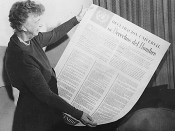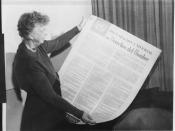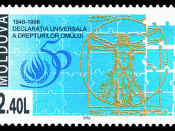Universal Declaration of Human Rights
1) background:
* The Universal Declaration of Human Rights, together with the International Covenant on Economic, Social and Cultural Rights, the International Covenant on Civil and Political Rights and its two Optional Protocols form the International Bill of Human Rights.
* In its resolution 217 A (III) of 10 December 1948 the General Assembly adopted the Universal Declaration of Human Rights.
* It was set up as "a common standard of achievement for all peoples and all nations".
2) preamble:
*
It refers to the "inherent dignity" and to the "equal and inalienable rights of all members of the human family" and it emphasizes their importance especially after a time of militarism, fascism and dehumanizing during World War II.
3) contents:
The document consists of the preamble and 30 articles.
* Article 1 lays down the basic idea on which the Declaration is based: "All human beings are born free and equal in dignity and rights.
They are endowed with reason and conscience and should act towards one another in a spirit of brotherhood." This article defines the basic assumptions of the Declaration: that all human beings have the right to liberty and equality because they are rational and moral beings and therefore different from other creatures on earth.
* Article 2 sets out the idea of equality and non-discrimination as to "race, colour, sex, language, religion, political or other opinion, national or social origin, property, birth or other status".
* Article 3 summarizes what is to follow in Articles 4 to 21 by giving the "right to life, liberty and security of person".
* Article 4 to 21 include civil and political rights, i.e.: freedom from slavery and servitude; freedom from torture and cruel, inhuman or degrading treatment; the right to recognition everywhere...


